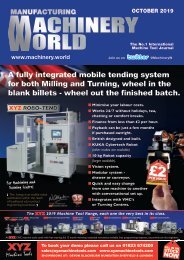Manufacturing Machinery World - June 2020
Machinery World was launched in 1982 to serve the machinery & production engineering market. Editorially Machinery World is a news and information source that gives direct contact with the provider of innovative services and equipment. Editorial is available both online and in hard copy. Machinery World carries news, views, projects, invites opinions and is a source of information readily available online and by smartphone.
Machinery World was launched in 1982 to serve the machinery & production engineering market.
Editorially Machinery World is a news and information source that gives direct contact with the provider of innovative services and equipment. Editorial is available both online and in hard copy.
Machinery World carries news, views, projects, invites opinions and is a source of information readily available online and by smartphone.
You also want an ePaper? Increase the reach of your titles
YUMPU automatically turns print PDFs into web optimized ePapers that Google loves.
ROBOTICS & AUTOMATION
ENSURING THE SUCCESS OF THE
‘COBOTICS’ MOVEMENT IN 2020
By Martin Walder, VP Industrial Automation at Schneider Electric
With the UK manufacturing industry under
increasing pressure to deliver more at a
lower cost, the coming years will see
manufacturers take steps to create a
completely ‘smart’ factory floor.
Thanks to recent advancements in
technologies, most notably with the
Industrial Internet of Things (IIoT), using
smart technology is feasible for a greater
number of manufacturers. However, a truly
‘smart factory’ is one that is completely
digitised with a high level of automation and
connectivity throughout its whole supply
chain.
There is a significant increase in the
demands for robots, and indeed cobots, as a
result of rising wages and skill shortages. As
automation developers introduce better
sensing/vision capabilities, ever more
complex applications can be tackled. More
responsive safety systems will also allow
cobots to work alongside humans with
greater flexibility, improving productivity,
hygiene and safety.
Robots are being used to carry out tasks
previously performed by humans, but in just
a fraction of the time. Robots are being
applied to the food and beverage industry to
assist in functions including; packing,
handling, quality control and even
maintenance.
THE EXPLOSION OF ‘COBOTICS’
Like many industrial processes, food and
drink production is always at risk from
human error, which can cause downtime,
poor quality and product loss, ultimately
increasing costs. To minimise these risks and
protect the production line, we are seeing the
introduction of ‘cobotics’ - compact, easy-touse
and collaborative robots to work
alongside humans.
As automation developers introduce
better sensing capability and more
responsive safety systems, the application of
robotic equipment in this space will only
increase – paving the way for improved
interaction so that complex processes can be
completed faster, more easily and more
safely.
With this change comes an additional
benefit for a skills-poor industry struggling
to attract engineering expertise. The cobotics
movement doesn’t replace humans, rather it
simply frees up highly skilled workers time
for more value-add activity.
MINIMISING THE RISKS
We are beginning to see how this
collaboration can minimise risks to
employees working on the factory floor.
Robots are able to perform more dangerous
and repetitive jobs that can often be
hazardous for humans, such cutting and
slicing. In turn, this allows workers to apply
their skills elsewhere. It also eases the social
implications of the trend, ensuring the two
parties can work in harmony towards
productivity goals, while tackling the
problem of engineering expertise retiring out
of the workforce.
With increasingly sophisticated sensors
and more highly functional robotic
equipment, the collaboration between
humans and machines on the factory floor is
imperative to ensure uniformity and
efficiency. This is because robots not only
reduce the chances of human error, but also
because they manage resources to achieve
the best margin. For example, food
manufacturers such as bakers have started to
notice increased productivity and quality as a
result of incorporating smart technologies
into their equipment. Connecting these
devices has shown it is possible to control
speed, precision and the volume of
ingredients, combining high turnover with
consistent quality.
THE JOURNEY TO SUCCESS
For food manufacturers to ensure that they
are getting the most out of their food lines,
it’s important that they implement robotics
and analytics. Ultimately, the only way to
protect the food line from human error or
equipment failure is to gather a greater
insight into processes – with the capability to
react in real-time. If we are to progress and
take manufacturing to the next level,
incorporating robotics into the production
line is a vital part of this and the health and
longevity of the sector relies on it.
For the ‘robotics and cobotics’ movement
to thrive, we must educate our workforce on
its benefits and capabilities. With greater
understanding, will come greater
implementation and proficiency. Over the
next ten years, we expect to see it proliferate
and manufacturers to reap the benefits of
greater efficiency, profitability and
performance. At the same time, any
manufacturing operations that do not adopt
digital technologies will get marginalised – if
not lost. Ultimately, legacy/non-connected
technologies do not fit into the digital
ecosystem, where analysis and optimisation
are fundamental.
We are set to see more manufacturers
recognise the true benefits of smart
manufacturing. In the meantime, increased
data insights and connectivity will lay solid
foundations for new, and more effective
business models.
www.se.com/uk
Manufacturing Machinery World, June 2020 23
















